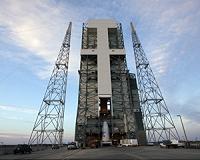 |
Brisbane, Australia (SPX) Feb 28, 2010 The University of Queensland will lead a $14 million international consortium to help develop scramjet-based access-to-space systems, flying an autonomous scramjet vehicle at eight times the speed of sound - Mach 8, or 8600 km/h. In parallel, scramjet concepts will be tested at even greater speeds, up to Mach 14, in UQ's world class hypersonic ground-test facilities. Scramjets are air-breathing engines capable of travelling at hypersonic speeds, greater than Mach 5. Scramjet-based launch systems offer considerable promise for safe, reliable and economical access to space. The project has been awarded $5 million in phase one of the Australian Space Research Program - the largest grant - and also attracts $9 million from an international partnership consortium. Chief investigator and project director Professor Russell Boyce of UQ said the project would answer key scientific and technological questions and build an industry-ready talent pool for a future Australian scramjet-based access-to-space industry. Professor Boyce said that current flight programs conducted in Australia were tackling the fundamental issues related to scramjet-powered atmospheric flight, at up to Mach 8. "The ultimate aim, however, is to reach high technology readiness levels for access to space. "This requires scramjet vehicles that can operate at much higher Mach numbers, up to say Mach 14, as part of a multi-stage rocket/scramjet system to accelerate a vehicle to the speed required to leave the earth's atmosphere. "No scramjet designs have been flight tested at these extreme speeds before now. "The gap cannot be easily closed in one leap, and a stepping-stone approach is required. "Our flight will build on the hypersonic flight experiments that have already been conducted by Australia, and will fly an exciting scramjet concept at the entry point to the scramjet access-to-space Mach range. "The knowledge we gain will position us for future, higher speed flights, but will also feed back into current efforts at the lower speeds. "Importantly, we will be training the talent pool for a future space-access industry with the hard core experience that only hypersonic flight experiments can provide. "In addition, the testing in UQ's X3 expansion tunnel will push two of our scramjet concepts up through the Mach range, up to Mach 14. No-one has ever done that before for a complete scramjet flowpath." Professor Boyce said the project represented the first phase of a 20-year program that ultimately would include ground testing, the development of new materials and flight testing at Woomera, South Australia. Partners in the new program include four Australian universities - UQ, the University of Adelaide, the University of New South Wales, and the University of Southern Queensland; and a US university, the University of Minnesota. It also includes three international aerospace organisations - DLR in Germany, JAXA of Japan and CIRA of Italy; Australia's Defence Science and Technology Organisation; the Australian Youth Aerospace Association; and industry partners including Brisbane firm Teakle Composites Pty Ltd, Cairns firm AIMTEK Pty Ltd, BAE Systems Australia, and Boeing Research and Technology Australia. "Access to - getting into - space is necessary for the deployment of space-based systems and technologies for communications, remote sensing, climate monitoring and space science, " Professor Boyce said. "Safe, economical and environmentally responsible access to space is a major technological challenge of the 21st century for all nations due to the dependence of the global economy on assured and secure access to space-based services. "The most promising way to meet this challenge is to extend aeronautical technology to hypersonic vehicles powered, at least partially, by supersonic combustion airbreathing engines (scramjets). "Scramjets can be combined with rockets to produce a more fuel-efficient hybrid launch system. "With the work performed by our domestic hypersonics community, including universities, industry and the Defence Science and Technology Organisation, Australia is internationally recognised as a world leader in this field of research and development." UQ Deputy Vice-Chancellor (Research) Professor Max Lu thanked the Federal Government for its support, and congratulated consortium members on the "fantastic result" which had been achieved by all groups contributing their expertise and in-kind materials. "It demonstrates what can be achieved when partners work collaboratively for the common love of technology and the goal of furthering knowledge," he said. "As well as the research outcomes, importantly this program will inspire young people to study aerospace engineering and related disciplines and to look towards the Australian space sector for their career. "This bodes well for a healthy Australian domestic space industry in years to come."
Share This Article With Planet Earth
Related Links University of Queensland Rocket Science News at Space-Travel.Com
 GOES-P To Launch Aboard Delta IV Rocket
GOES-P To Launch Aboard Delta IV RocketCape Canaveral FL (SPX) Feb 26, 2010 Geostationary Operational Environmental Satellite-P, or GOES-P, is the latest in a series of meteorological satellites designed to watch for storm development and weather conditions on Earth. From its location in Earth orbit, GOES-P's state-of-the-art instrumentation will supply data used in weather monitoring, forecasting and warnings. It also will detect ocean and land temperatures ... read more |
|
| The content herein, unless otherwise known to be public domain, are Copyright 1995-2010 - SpaceDaily. AFP and UPI Wire Stories are copyright Agence France-Presse and United Press International. ESA Portal Reports are copyright European Space Agency. All NASA sourced material is public domain. Additional copyrights may apply in whole or part to other bona fide parties. Advertising does not imply endorsement,agreement or approval of any opinions, statements or information provided by SpaceDaily on any Web page published or hosted by SpaceDaily. Privacy Statement |